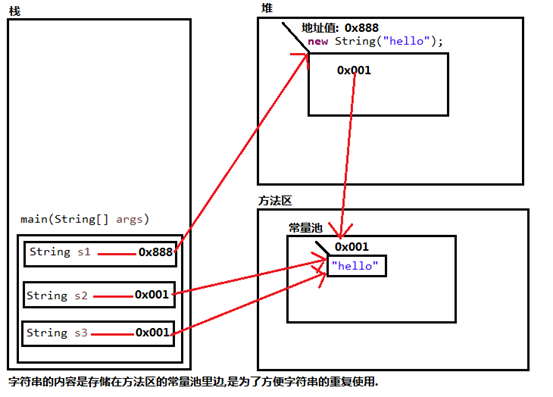今日学习目标
- 能够明确API的使用步骤
- 能够使用Scanner类获取键盘输入的字符串
- 能够使用String类的构造方法创建字符串对象
- 能够明确String类的构造方法创建对象,和直接赋值创建字符串对象的区别
- 能够使用文档查询String类的判断方法
- 能够使用文档查询String类的获取方法
- 能够使用文档查询String类的转换方法
第1章 API文档
1.1 概述
- API(Application Programming Interface) --- 应用程序编程接口
- 编写一个机器人程序去控制机器人踢足球,程序就需要向机器人发出向前跑、向后跑、射门、抢球等各种命令,没有编过程序的人很难想象这样的程序如何编写。但是对于有经验的开发人员来说,知道机器人厂商一定会提供一些用于控制机器人的Java类,这些类中定义好了操作机器人各种动作的方法。其实,这些Java类就是机器人厂商提供给应用程序编程的接口,大家把这些类称为API。
- Java API就是JDK中提供给我们使用的类,这些类将底层的代码实现封装了起来,我们不需要关心这些类是如何实现的,只需要学习这些类如何使用即可。
- 在JDK安装目录下有个src.zip文件,这个文件解压缩后里面的内容是所有Java类的源文件。可以在其中查看相对应的类的源码。
- 我们在每次查看类中的方法时,都打开源代码进行查看,这种方式过于麻烦。其实,我们可以通过查帮助文档的方式,来了解Java提供的API如何使用。
1.2 使用步骤
- 打开帮助文档
- 点击显示,找到索引,看到输入框
- 你要找谁?
- 在输入框里输入,然后回车
- 看包
- java.lang下的类不需要导包,其他需要
- 看类的解释和说明
- 学习构造方法
- 使用成员方法
1.3 API的使用(Scanner类)
- 获取键盘录入的字符串数据
public class DemoScanner { public static void main(String[] args) { //创建键盘录入对象 Scanner sc = new Scanner(System.in); //接收数据 System.out.println("请输入一个字符串数据:"); String s = sc.nextLine(); //输出结果 System.out.println("s:"+s); } }
1.4 next和nextLine的区别(思考)
第2章 String类
2.1 String概述
- 字符串是由多个字符组成的一串数据
- 字符串可以看成是字符数组
2.2 构造方法
- 构造方法
-
- public String(String original)把字符串数据封装成字符串对象
- public String(char[] value)把字符数组的数据封装成字符串对象
- public String(char[] value,int offset,int count)把字符数组中的一部分数据封装成字符串对象
- 直接赋值也可以是一个对象(定义一个字符串变量)
- 注意:字符串是一种比较特殊的引用数据类型,直接输出字符串对象输出的是该对象中的数据。
public class Demo01String { public static void main(String[] args) { //方式1 //String(String original):把字符串数据封装成字符串对象 String s1 = new String("hello"); System.out.println("s1:"+s1); System.out.println("----------"); //方式2 //String(char[] value):把字符数组的数据封装成字符串对象 char[] chs = {'h','e','l','l','o'}; String s2 = new String(chs); System.out.println("s2:"+s2); System.out.println("-----------"); //方式3 //String(char[] value,int index,int count):把字符数组中的一部分数据封装成字符串对象 //String s3 = new String(chs,0,chs.length); String s3 = new String(chs,1,3); System.out.println("s3:"+s3); System.out.println("----------"); //方式4 String s4 = "hello"; System.out.println("s4:"+s4); } }
String的特点(区别)
- 通过构造方法创建字符串对象
- String s = new String(“hello”);
- 直接赋值创建字符串对象
- String s = “hello”;
- 区别是什么?
public class Demo02String { public static void main(String[] args) { String s1 = new String("hello"); String s2 = "hello"; System.out.println("s1:"+s1);//s1:hello System.out.println("s2:"+s2);//s1:hello System.out.println("s1==s2:"+(s1==s2));//s1==s2:false String s3 = "hello"; System.out.println("s1==s3:"+(s1==s3));//s1==s3:false System.out.println("s2==s3:"+(s2==s3));//s2==s3:true } }
1.1 常用方法
- 判断功能方法
- boolean equals(Object obj):比较字符串的内容是否相同
- boolean equalsIgnoreCase(String str):比较字符串的内容是否相同,忽略大小写
- boolean startsWith(String str):判断字符串对象是否以指定的str开头
- boolean endsWith(String str):判断字符串对象是否以指定的str结尾
public class Demo03String { public static void main(String[] args) { //创建字符串对象 String s1 = "hello"; String s2 = "hello"; String s3 = "Hello"; //boolean equals(Object obj):比较字符串的内容是否相同 System.out.println(s1.equals(s2));//true System.out.println(s1.equals(s3));//false System.out.println("------------"); //boolean equalsIgnoreCase(String str):比较字符串的内容是否相同,忽略大写 System.out.println(s1.equalsIgnoreCase(s2));//true System.out.println(s1.equalsIgnoreCase(s3));//true System.out.println("------------"); //boolean startsWith(String str):判断字符串对象是否以指定的str开头 System.out.println(s1.startsWith("he"));//true System.out.println(s1.startsWith("ll"));//false } }
练习:模拟用户登录
- 获取功能方法
- int length():获取字符串的长度,其实也就是字符个数
- char charAt(int index):获取指定索引处的字符
- int indexOf(String str):获取str在字符串对象中第一次出现的索引,没有返回-1
- String substring(int start):从start开始截取字符串到字符串结尾
- String substring(int start,int end):从start开始,到end结束截取字符串;包括start,不包括end
public class DemoString { public static void main(String[] args) { //创建字符串对象 String s = "helloworld"; //int length():获取字符串的长度,其实也就是字符个数 System.out.println(s.length());//10 System.out.println("----------"); //char charAt(int index):获取指定索引处的字符 System.out.println(s.charAt(0));//h System.out.println(s.charAt(1));//e System.out.println("----------"); //int indexOf(String str):获取str在字符串对象中第一次出现的索引,没有返回-1 System.out.println(s.indexOf("l"));//2 System.out.println(s.indexOf("owo"));//4 System.out.println(s.indexOf("ak"));//-1 System.out.println(s.indexOf("-----------"));//-1 //String substring(int start):从start开始截取字符串到字符串结尾 System.out.println(s.substring(0));//hello System.out.println(s.substring(5));//world System.out.println("----------"); //String substring(int start,int end):从start开始,到end结束截取字符串.包括start,不包括end System.out.println(s.substring(0, s.length()));//helloworld System.out.println(s.substring(3,8));//helloworld } }
练习:字符串的遍历
public class Demo02StringTest { public static void main(String[] args) { //创建一个字符串对象 String s = "abcde"; //原始做法 System.out.println(s.charAt(0)); System.out.println(s.charAt(1)); System.out.println(s.charAt(2)); System.out.println(s.charAt(3)); System.out.println(s.charAt(4)); System.out.println("-----------"); //用for循环改进 for(int x=0;x<5;x++){ System.out.println(s.charAt(x)); } System.out.println("-----------"); for(int x=0;x<s.length();x++) System.out.println(s.charAt(x)); } }
练习:统计字符串中大写、小写及数字字符个数
public class Demo03StringTest { public static void main(String[] args) { //键盘录入一个数 Scanner sc = new Scanner(System.in); System.out.println("请输入一个字符串数据:"); String s = sc.nextLine(); //定义三个统计变量,初始化值都是0 int bigCount = 0; int smallCount = 0; int numberCount = 0; //遍历字符串,得到每一个字符 for(int x=0;x<s.length();x++){ char ch = s.charAt(x); //拿字符进行判断 if(ch >= 'A' && ch <= 'Z'){ bigCount++; }else if(ch >= 'a' && ch <= 'z'){ smallCount++; }else if(ch >= '0' && ch <= '9'){ numberCount++; } } //输出结果 System.out.println("大写字符:"+bigCount+"个"); System.out.println("小写字符:"+smallCount+"个"); System.out.println("数字字符:"+numberCount+"个"); } }
- 转换功能方法
- char[] toCharArray():把字符串转换为字符数组
- String toLowerCase():把字符串转换为小写字符串
- String toUpperCase():把字符串转换为大写字符串
public class Demo01String { public static void main(String[] args) { //创建字符串对象 String s = "abcde"; //char[] toCharArray():把字符串转换为字符数组 char[] chs = s.toCharArray(); for(int x=0;x<chs.length;x++){ System.out.println(chs[x]);//a b c d e } System.out.println("-----------"); //String toLowerCase():把字符串转换为小写字符串 System.out.println("HelloWorld".toLowerCase());//helloworld //String toUpperCase():把字符串转换为大写字符串 System.out.println("HelloWorld".toUpperCase());//HELLOWORLD } }
练习:键盘录入一个字符串,把该字符串的首字母转成大写,其余为小写。
public class Demo02StringTest { public static void main(String[] args) { //键盘录入一个字符串 Scanner sc = new Scanner(System.in); System.out.println("请输入一个字符串"); String s = sc.nextLine(); //截取首字母 String s1 = s.substring(0, 1); //截取除了首字母以外的字符串 String s2 = s.substring(1); //2转大写+3转小写 String s3 = s1.toUpperCase()+s2.toLowerCase(); //输出即可 System.out.println("s3:"+s3); } }
去除空格和分割功能方法
- String trim()去除字符串两端空格
- String[] split(String str)按照指定符号分割字符串
public class Demo01String { public static void main(String[] args) { //创建字符串对象 String s1 = "helloworld"; String s2 = " helloworld "; String s3 = " hello world "; System.out.println("---"+s1+"---");//---helloworld--- System.out.println("---"+s1.trim()+"---");//---helloworld--- System.out.println("---"+s2+"---");//--- helloworld --- System.out.println("---"+s2.trim()+"---");//---helloworld--- System.out.println("---"+s3+"---");//--- hello world --- System.out.println("---"+s3.trim()+"---");//---hello world--- System.out.println("---------------------------------------"); //String[] split(String str) //创建字符串对象 String s4 = "aa,bb,cc"; String[] strArray = s4.split(","); for(int x=0;x<strArray.length;x++){ System.out.println(strArray[x]);//aa bb cc } } }
练习:把数组中的数据按照指定格式拼接成一个字符串
举例:int[] arr = {1,2,3}; 输出结果:[1, 2, 3]
public class Demo01StringTest { public static void main(String[] args) { //定义一个int类型的数组 int[] arr = {1,2,3}; //调用方法 String s = arrayToString(arr); //输出结果 System.out.println("s:"+s); } /* * 写方法实现把数组中的元素按照指定的格式拼接成一个字符串 * 两个明确: * 返回值类型:String * 参数列表:int[] arr */ public static String arrayToString(int[] arr) { String s =""; s += "["; for(int x = 0;x<arr.length;x++){ if(x == arr.length-1){ s += arr[x]; s += "]"; }else{ s += arr[x]; s += ","; } } return s; } }
练习:字符串反转(两种方式)
- 替换功能方法
- String replace(char oldChar,char newChar)替换字符串中的单个字符
- String replace(CharSequence oldStr, CharSequence newStr)替换字符串中的指定内容
public class Demo02String { public static void main(String[] args) { String str = "itcast itheima"; //字符串对象方法replace替换字母t为大写T str = str.replace('t', 'T'); System.out.println(str); } }
练习:键盘输入数据,将数据中的字符@,替换成*
public class Demo03String { public static void main(String[] args) { Scanner sc = new Scanner(System.in); System.out.println("请输入一个数"); String str = sc.nextLine(); str = str.replace('@','*'); System.out.println(str); } }
